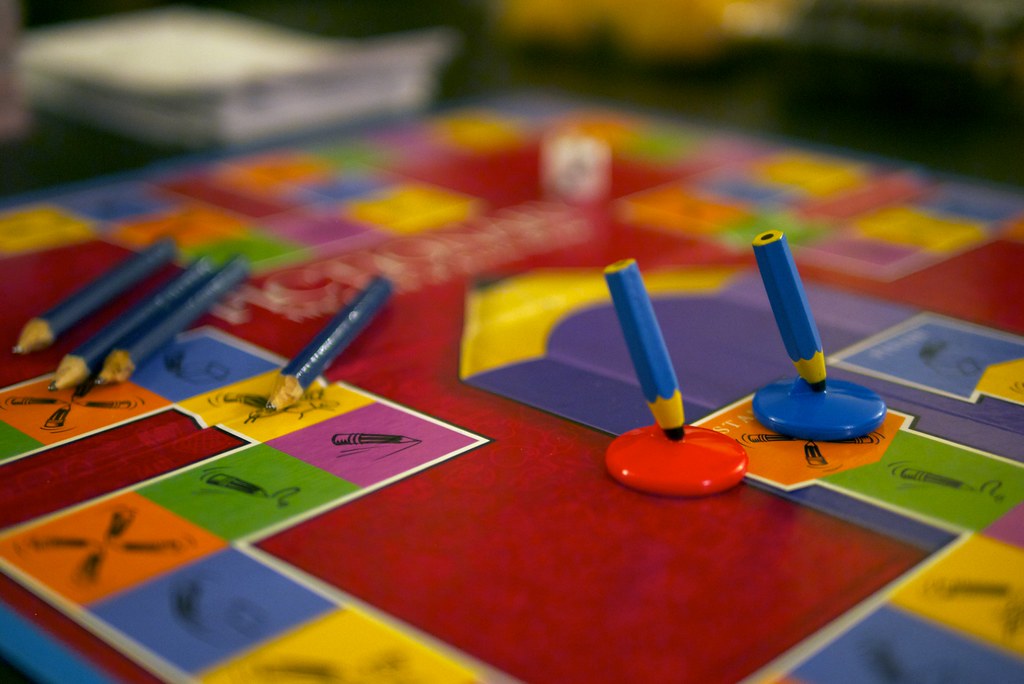Pictionary
Provide a version of the action board game Pictionary to gamify a review or test prep period. Use chart paper in-class or Zoom Annotate tool in an online synchronous class and supply your own concepts and terms for students to draw.

Pictionary for Learning
These tips aim to help you use a modified game of Pictionary effectively to support learners. The key learning strengths of a Pictionary session can be:
- use after a lesson where new vocabulary was introduced
- retrieval practice of key concepts, solutions, ideas, or visuals
- collaborative and team-based support for for learning
- a targeted understanding of particular topics for an assessment
Game Summary
Students may not be familiar with the game and its rules, so it’s a good idea to summarize the goals, process, and rules. You may even want to play a practice round so that everyone understands the flow of the game.
Here is a game summary you can use and adapt:
In this game, players must guess the correct word that is drawn by an Artist within a specific time frame. The first player is given a word to draw. A timer starts, and the Artist draws images that will help their team members to guess the word(s) before the timer goes off. If the team members guess correctly, they get a point. If they do not, then the other team can guess the word(s) to steal a point. Then, the other team plays a round. Play continues for a certain number of rounds or a time period elapses. The team with the highest point value wins!
You may wish to modify some of the Pictionary game rules (like no words, symbols, or gestures) if it helps students to guess answers and make connections to the course content.
Modes of Delivery
For in-person games, teams can draw different words at the same time using a whiteboard or chart paper. See a video demonstration of an in-person Pictionary game. English for Asia (2010). 12. Pictionary Race. [Video].
For online synchronous games, each team has one drawer at a time using Zoom Annotate or Microsoft Draw. See a video demonstration of an online synchronous Pictionary game. EclipseEffectEvents. (2020). Virtual Event Games: Pictionary. [Video].
Teams for Collaborative Learning
This is a team-based activity that works will with small or medium-sized groups. Encourage students to cooperate, take turns, and think about how their learning can benefit from working together as a team. This may includes reminding students about keeping to the rules, refraining from drawing inappropriate images, etc. At the same time, let students know they don’t have to be good artists to play Pictionary–guessing is important too!
Offer rewards, such as a helpful hint for the test, so that everyone feels that they have “won.”
Review Answers and Categories
After a few rounds, check in with students to think about how well their team has scored, how difficult the rounds were, and whether they might need to revisit this topic before the test or exam. Connect the terms to other related course topics. Ask each group to identify the topics they are strongest in, and could use the most practice in.
Caution Points
Consider the level of learning. Pictionary more readily tests lower levels of thinking skills (Peterson, 2017), so it is important to combine debrief questions and discussion to address higher order thinking.
This game might not be culturally relevant for all learners. Set the context by reviewing images, diagrams, terminology in advance of the game. Explain the cultural significance of this particular board game.
Students may have limited technology access. For online synchronous classes, students may not strong internet connection, access to Zoom Annotate, or use of the microphone. As a result, not everyone may be able to participate in play. Students may be invited to score keep or keep a list of correct answers to support their team.
There are web-based tools for Pictionary, but they often require the faculty to create an account to access the tool: Top 6 Pictionary Games.
Students may not be able to play games with others. Consider creating handouts, such as graphic organizers for recording answers, that cover the same terms and topics for students who can’t handle playing games.
References
Peterson S. N. (2017). Using a modified version of Pictionary to help students review course material. Journal of microbiology & biology education, 18(3), 18.3.63.



